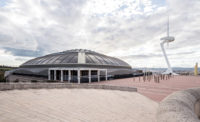SelgasCano's Surreal Auditorium in Western Spain
Plasencia, Spain

Circulation routes, which occupy spaces between the building’s ETFE skin and glass walls, are visible through the translucent facades.
Photo © Iwan Baan

Circulation routes, which occupy spaces between the building’s ETFE skin and glass walls, are visible through the translucent facades.
Photo © Iwan Baan

The auditorium’s seating occupies the congress center’s sloped cantilever.
Photo © Iwan Baan

A variety of multipurpose halls play with light and color and reveal surprising views within and through the building. A glass floor in one reveals the large portal that cuts through the building.
Photo © Iwan Baan

A variety of multipurpose halls play with light and color and reveal surprising views within and through the building. A glass floor in one reveals the large portal that cuts through the building.
Photo © Iwan Baan

A variety of multipurpose halls play with light and color and reveal surprising views within and through the building. A glass floor in one reveals the large portal that cuts through the building.
Photo © Iwan Baan

The main entry vestibule occupies the first level of the portal. Round skylights and open sides admit daylight.
Photo © Iwan Baan







Architects & Firms
It sounds like a question for “Dear Abby”: how can the Spanish architects José Selgas and Lucia Cano reconcile their passion for nature with these crazy retro-’60s sci-fi plastic spaceships they love to build? In their auditorium and congress center for the ancient city of Plasencia in western Spain, their design took off from the premise of refusing to fill or urbanize the site—a steep hillside—opting instead to preserve its arid, rocky landscape dotted with wild mountain shrubs. Their building occupies the parcel as lightly as possible, with the sloping volume that holds the auditorium seating cantilevered off the ground. Originating with a 2005 competition, but completed only this year due to financing problems, the congress center is perched just beyond the city’s edge, standing out in its harsh habitat as an exotic, multifaceted boulder sheathed in pale, translucent panels of ETFE. Like a moated castle, it has a gangway entry, which is announced by its brilliant orange hue, and leads to a monumental, color-saturated entry porch. This space passes right through the building to a lookout on the other side that offers views toward the Sierra de Gata mountains.
The natural terrain lies 57 feet below the artificial grade of the roadway, Cano points out, so the challenge was “how to raise the building to street level,” a trick the team accomplished by locating the entry portal on top of the auditorium. From there, stairs and ramps feed down the building’s sides, between the ETFE and the concrete structure, to access the building. A smaller hall, meeting rooms, and an exhibition space pile up over the main hall, enabling the fly tower to be fully incorporated in the volume. The ETFE functions “like a raincoat” in Plasencia’s relatively mild climate, Cano explains, and the perimeter ramps are open to views and weather at several points.
The plastic congress center is alien to both its natural setting and to the scruffy city outskirts behind it, a condition underscored at night, when the skin becomes a glowing lantern. Inside, this sense of estrangement is all-encompassing. The ETFE, luminous in daylight, transforms the perimeter circulation areas and upper stories—with their planes of soft yellow and pale aquamarine floors and ceilings—into numinous, otherworldly spaces. Into this ethereal realm, the slash-cut of the entry portal pops with its vivid oranges, yellows, and pinks, while the auditorium’s red seating, floor, and the lower portions of its walls make this space “the warm heart” of the building, according to Cano.
The design further develops strategies Selgas and Cano first explored in their Congress Center for nearby Badajoz, including the use of contrasting colors, translucent plastic surfaces, and a variety of playful circular elements, here ranging from rounded glass doors to thick portholes and HVAC nozzles. The overall scheme, with its faceted geometry and mazelike circulation, echoes that of Rem Koolhaas’s Casa da Música in Porto, Portugal, though it is soft and womblike in contrast to Koolhaas’s hard geode. And while the Porto project is urban, the Plasencia building addresses its expansive natural setting as a whole. Says Cano, “It’s like a rock that is poised over the landscape but could fly away at any moment.”











